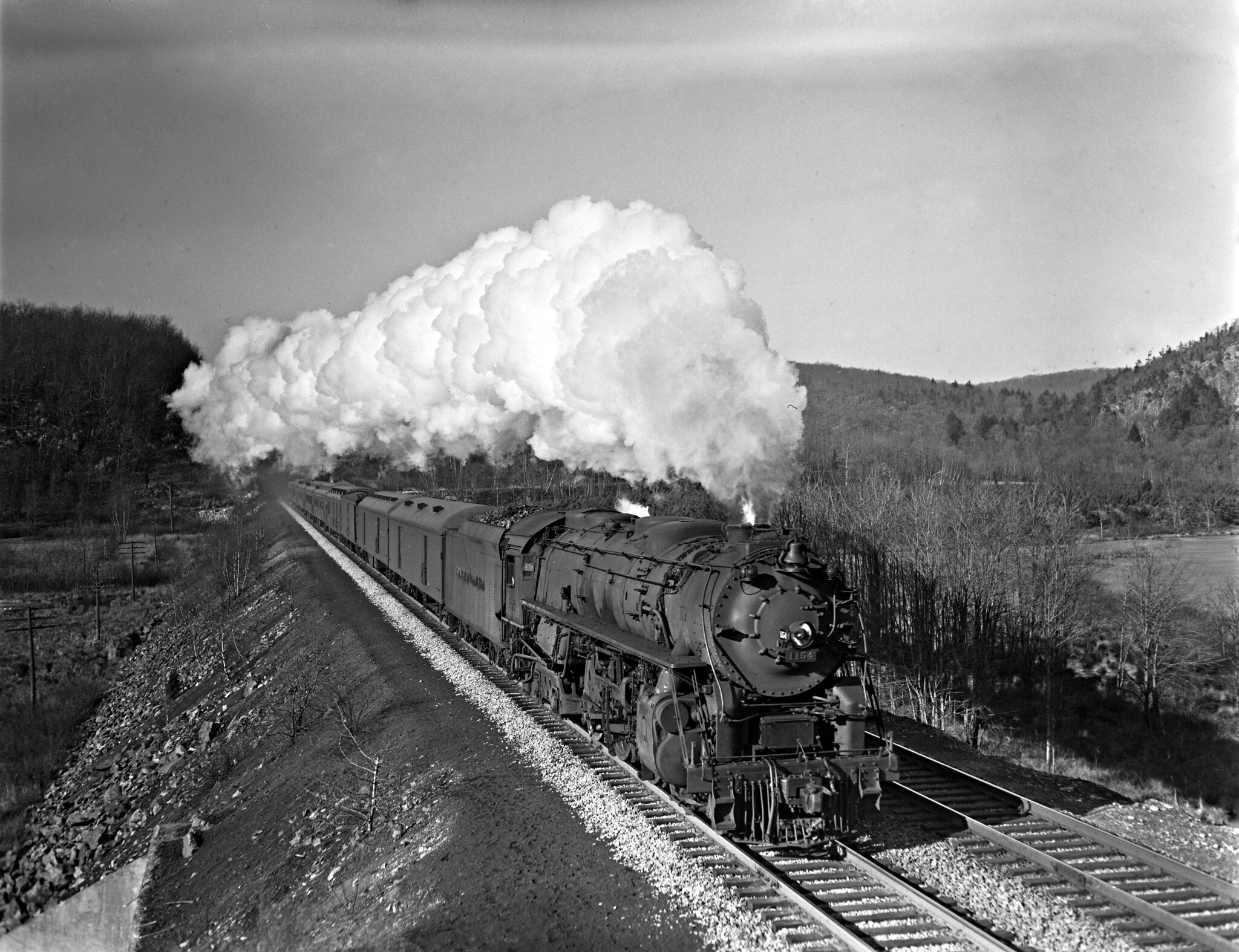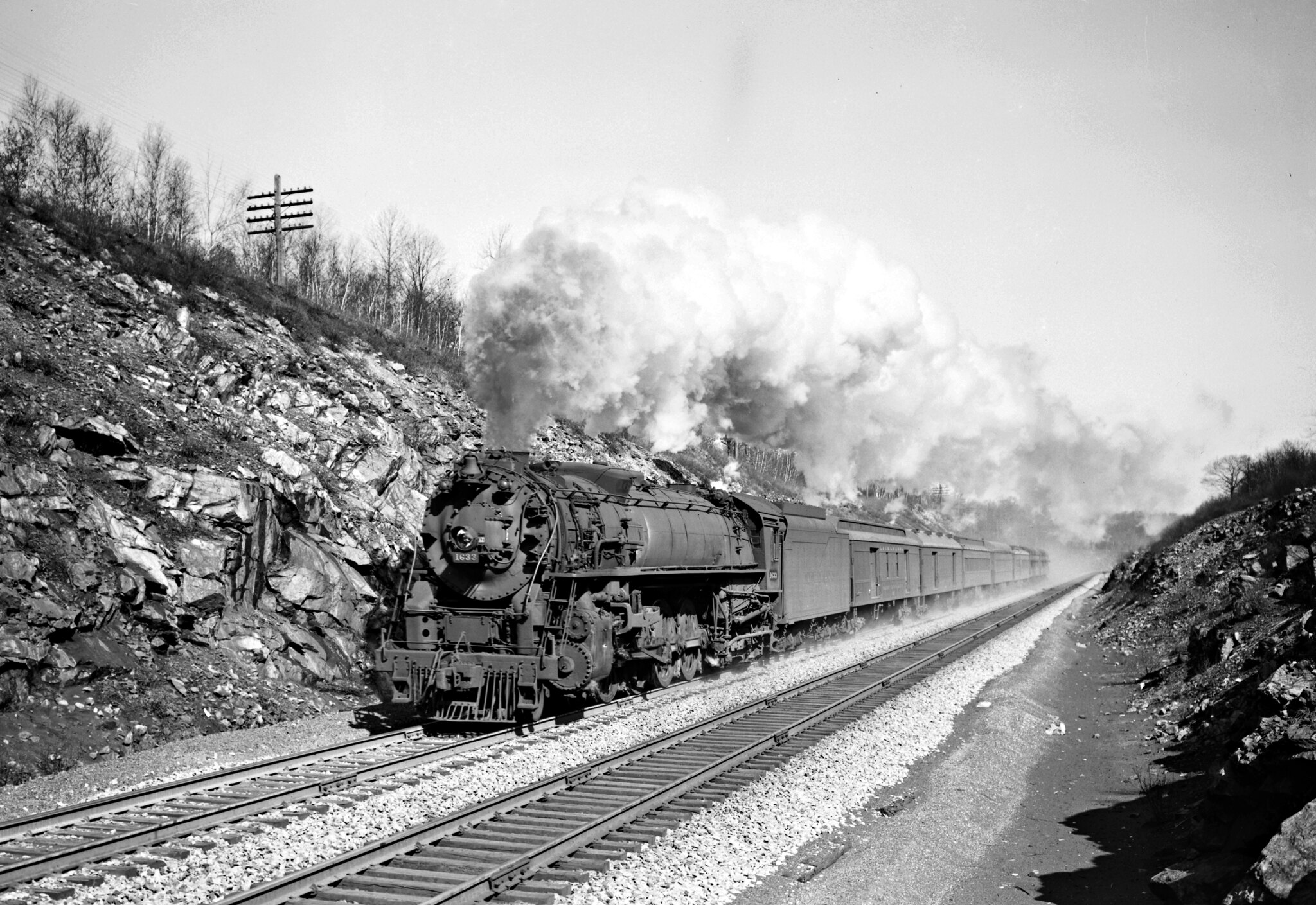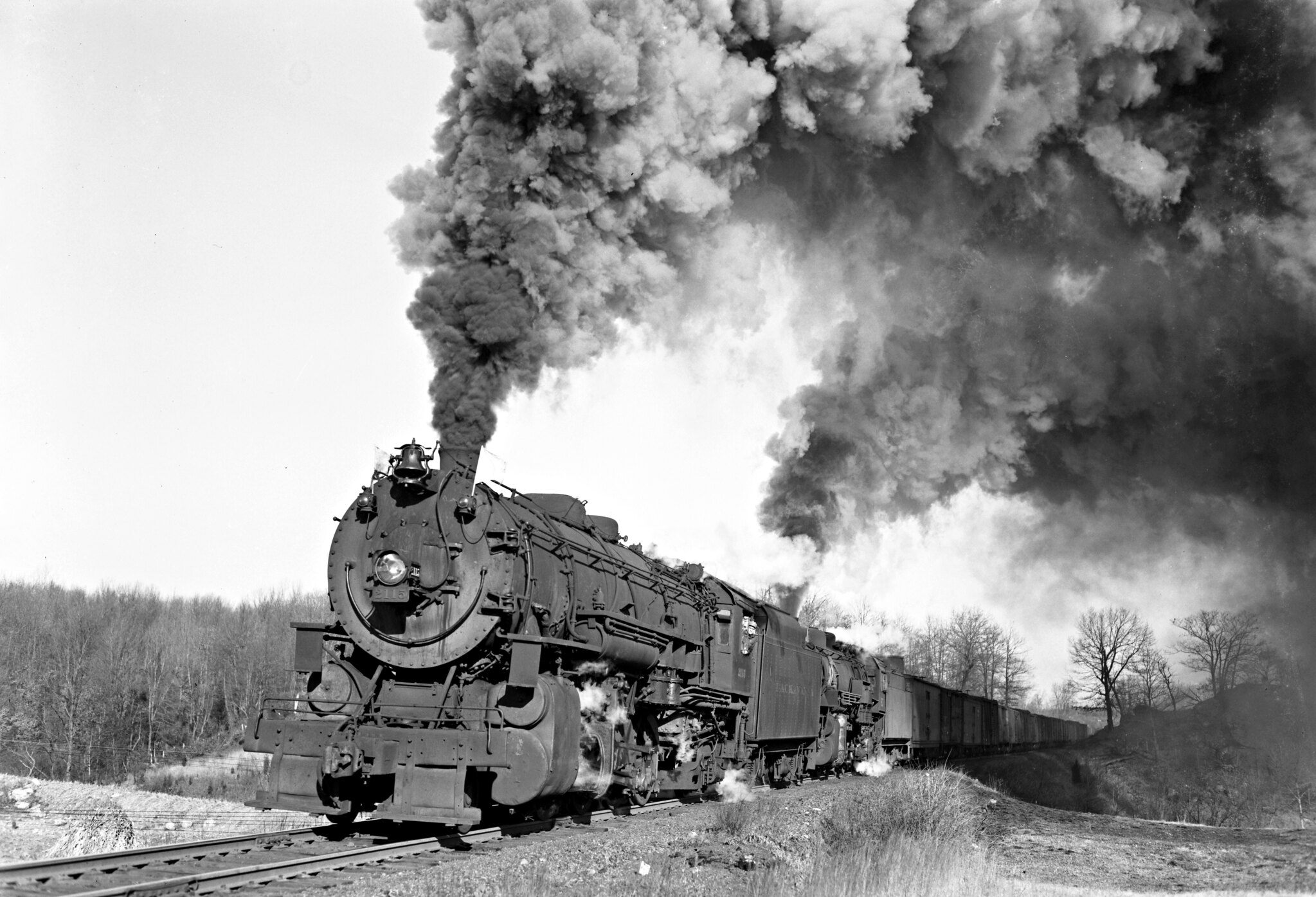
NickD
MegaDork
12/31/21 9:40 a.m.
The Erie was never as attached to the Camelback design or the Wootten firebox as the other anthracite roads, but what they lacked in quantity, they made up for in size. In 1907, Alco constructed three L-1 class compund 0-8-8-0 Camelbacks for the Erie for use in pusher service on the Susquehanna Division. The L-1s were the largest Camelbacks ever built and the only articulated Camelbacks ever constructed. With 51" drivers, 39" x 28" low pressure cylinders, 25" x 28" high pressure cylinders, and 88,890lbs of tractive effort, they were slow but brawny engines. Probably a good thing too, since the L-1s were hand-fired engines. Yes, some poor bastard (or possibly two) was back there shoveling for all he was worth to keep it fed. In 1921, they were sent to Baldwin, where they had single-axle lead and trailing trucks installed, along with superheater elements and a mechanical stoker and were converted to a conventional rear-cab construction. They served like this until 1930.
Erie's only other real experiments with articulated power were the disastrous Triplex 2-8-8-8-2s and a very unusual 2-6-8-0. The latter was built from a 2-8-0 with a kit that Baldwin marketed that was designed to replace the lead truck with a 2-6-0 front engine with low-pressure front cylinders. The railroad then was to lengthen the boiler to match, allowing conversion of older power into bigger Mallets to suit growing need. It proved to be too small and underpowered for the grade on the Susquehanna Division, and Erie converted the Consolidation back to its original configuration and did not purchase any more of these "Build-A-Mallet" kits.


NickD
MegaDork
12/31/21 11:13 a.m.
The Delaware, Lackawanna & Western, rival and eventual marriage partner to the Erie, billed itself as "The Road Of Anthracite" and so was a bit more devoted to the Camelback and Wootten firebox, although none quite matched the Reading in their dedication to anthracite-burning engines. Here, one of the DL&W's H-5a-sh Ten-Wheelers gets turned at Paterson Junction.


NickD
MegaDork
12/31/21 11:43 a.m.
Later in life, some DL&W Camelbacks were rebuilt into rear-cab engines with questionable aesthetic intent, like this 4-4-0 near Lake Hopatcong, NJ


NickD
MegaDork
12/31/21 11:46 a.m.
Another converted 4-4-0 near Waterloo, NJ. The DL&W even streamlined one of their wide firebox 4-4-0s, which made it the only streamlined 4-4-0 in the US. The sheetmetal cladding did nothing to improve it's appearance.


NickD
MegaDork
12/31/21 11:57 a.m.
A DL&W H-2b Ten-Wheeler near Towaco, NJ. The H-2bs were originally built as saturated steam Camelbacks with inboard Stephenson valve gear in 1905, and were rebuilt by the DL&W in 1916 as superheated, rear-cab engines with Walschaerts valve gear. Aesthetically these came out pretty decent, certainly better than the 4-4-0s


NickD
MegaDork
12/31/21 12:03 p.m.
The DL&W also streamlined one of the converted Ten-wheelers in a manner similar to the 4-4-0 and a streamlined 4-6-2 that they had as well. Stylistically, it was questionable, with the running board skirts shaped like giant wings and bright green and red paint. Supposedly industrial designer Otto Kuhler saw it in person for the first time and started looking up under the running boards, and when asked what he was doing by DL&W managment, he sarcastically remarked that he was looking for the mechanism to make the wings flap.


NickD
MegaDork
12/31/21 12:13 p.m.
DL&W N-3 Pacific #1154 emerges from a tunnel east of Andover on the Lackawanna Cutoff. The N-3s were built in 1913 to replace the E-11 Moguls as a fast freight engine, and took the basic design of the earlier N-1, N-2, and N-2a Pacifics and replaced the firebox designed for a anthracite with a bituminous-burning firebox package, and the 73" drivers with 69" drivers. By 1940, the #1154 has been displaced from fast freight usage by the arrival of bigger 4-8-4 "Poconos".


NickD
MegaDork
12/31/21 12:22 p.m.
A DL&W anthracite-burning Pacific at Lake Hopatcong with a passenger train. The DL&W preferred to use anthracite-burning engines for passenger service, since anthracite burned cleaner and produced significantly less ash and cinders. This actually factored heavily into the DL&W's passenger department advertisement, with them creating the fictional character of Phoebe Snow, a woman dressed all in white. There was always a corresponding poem, such as:
Says Phoebe Snow
about to go
upon a trip to Buffalo
"My gown stays white
from morn till night
Upon the Road of Anthracite"
Phoebe Snow was retired during WWI, when anthracite was viewed as vital to the war effort and so they had to resort to burning bituminous coal in their passenger locomotives. Phoebe Snow would make a return in 1949, when the DL&W inaugurated a new passenger train called the Phoebe Snow, although by that point the DL&W was using diesel locomotives to haul passenger trains, and so the advantages of anthracite were no longer expounded to the riding public.


NickD
MegaDork
12/31/21 12:29 p.m.
The Lackawanna Limited crosses the Delaware River near Portland, PA with one of the Q-1 Poconos on the lead. After taking delivery of the first five dual-purpose 4-8-4s in 1927, the DL&W, like the Lehigh Valley, never looked back and ordered several more batches of the big 4-8-4s. The car directly behind the locomotive tender that looks like a butter dish is exactly that. Borden's Dairy had a number of milk tank cars constructed that were designed to look like a butter dish and were commonly slipped into passenger consists to get them where they needed to go fast.


NickD
MegaDork
12/31/21 12:36 p.m.
A DL&W P-5 Mountain near Blairstown, NJ. The flat-bottom smokebox is a giveaway that this is a 3-cylinder locomotive. The DL&W had owned some 73" drivered, 3-cylinder Mountains, class P-2 and P-3, for passenger usage, but the high speeds chewed up the center cylinder running gear, resulting in them being converted to 2-cylinder engines in 1940. That made them easier on maintenance but crews remarked "they weren't made of the same stuff" afterwards. The later P-4 and P-5s had 63" drivers and were more like a heavy Mikado with an extra front axle to support the additional cylinder. Because they were run at lower speeds, they had less trouble with the center cylinder and so they retained their 3-cylinder configuration until retirements between 1946-1950.


NickD
MegaDork
12/31/21 12:38 p.m.
A P-4 Mountain emerging from the Roseville Tunnel near Andover on the Lackawanna Cutoff. Interesting that there is an RPO tucked in on the front of the train. Perhaps a hospital move or deadhead move.


NickD
MegaDork
12/31/21 3:01 p.m.
The DL&W had received an allotment of USRA Heavy Mountains, which had been their class P-1, and decided in '27 that they would like more engines, but larger. It was determined that to support a larger engine, a larger firebox was needed, and correspondingly a 2-axle trailing truck was necessary. And so the first Q-1 Poconos were delivered, followed by another 50 spread across three more classes.


LS_BC8
New Reader
12/31/21 3:41 p.m.
The controversial DL&W camelback 952 sits at St.Louis Museum of Transport.

NickD
MegaDork
1/2/22 8:36 a.m.
In reply to LS_BC8 :
The situation with DL&W #952 was dumb. For those not familiar, the Lackawanna chapter of the Railroad & Locomotive Historical Society wanted to get it back from the National Museum of Transportation in St. Louis and restore it to operation at Steamtown, supposedly backed by people with deep pockets, or so they claimed. They tried to make some trade offer with the NMoT for it, but the R&LHS doesn't own any locomotives, so they were in essence trying to trade off something they didn't own from a museum that wasn't involved for something that the owner had no interest in trading off. That obviously fell through and they then repeatedly made other offers, and when they NMoT still wouldn't agree, the R&LHS sued them and lost (go figure). Meanwhile, sitting at Steamtown was already another DL&W steam locomotive, rear 2-6-0 #565, that they could have just put all that money towards instead (this was before the aborted restoration that left #565 disassembled) and maybe have gotten that running. And even if they had gotten the #952 back and restored it, its a 4-4-0 with like 20,000lbs tractive effort. Steamtown got rid of their CPR G-5 Pacifics because they were too underpowered for the grades on the line. And where were you going to find a crew that really wanted to run a Camelback at track speeds?

NickD
MegaDork
1/2/22 10:04 a.m.
Caught this moving through Rome yesterday, completely on accident. A single CSX ES40DC towing an oversized load on a huge 16-axle drop center flatbed with span-bolster trucks, plus a caboose. They were moving westbound at a very slow rate of speed. If I had to guess, its some sort of power-generating equipment, maybe from the GE plant in Schenectady.




NickD
MegaDork
1/3/22 8:17 a.m.
DL&W #1153, one of the railroad's five M-1 class 4-6-4s. Delivered in 1937, these largely-forgotten Hudsons were fast, powerful engines specifically designed to pull 16-18 cars at 80 mph. but the speed limit on the route was 70 mph and the trains were rarely ever more than 8 to 10 cars. With 80" drivers, 245psi boiler pressures, 26"x30" cylinders, and 52,791lbs of tractive effort, these were big, powerful, flatland engines, beating even the New York Central's famed J-3a Hudsons by a sizable margin, and their 80" drivers were unparalleled on the DL&W. They also proved to be the final steam locomotives ordered by the DL&W, arriving in 1937, and five locomotives only lasted ten years in their original intended assignments, since the Lackawanna dieselized its express passenger trains in 1947. The Hudsons were relegated to lesser assignments such as commuter trains, and began to be seen on the eastern end of the railroad. By '52, all five were withdrawn from service. Cosmetically, they were a handsome engine, only marred by the weird inward-sloping dome that was a curiousity seen only on late DL&W steam power.


NickD
MegaDork
1/3/22 9:57 a.m.
Q-4 Pocono #1633 near Lake Lackawanna with a passenger train. Despite it's assignment in this photo, and the fact that the Q-4s were ordered with 74" drivers compared to the 70" drivers on the Q-1/2/3s, the Q-4s were primarily intended to handle fast freights from Binghamton to Buffalo, on the west end of the line. They did on occasion get assigned to perishable freight runs east to Hoboken and then were worked back west by being assigned to passenger runs. Again, the Q-4 is equipped with that strange inward-slowing sand dome that was a DL&W peculiarity, and they were also equipped with air horns instead of a steam whistle. Several railroads discovered that a whistle's sound was less effective at speeds over 50mph, and so equipped their steam engines with air horns, either as a replacement for or in addition to. These included MILW's S-class Northerns, NYC's Niagaras, DL&W's Poconos.


NickD
MegaDork
1/3/22 10:49 a.m.
Later in life, some of the Q-2s and Q-3s had their smokeboxes extended to make room for a Cyclone self-cleaning front end. Because this would have made the headlight stick out past the pilot beam and prone to being damaged when the front coupler was used, they were relocated to the top of the smokebox.


NickD
MegaDork
1/3/22 12:08 p.m.
A DL&W Mikado and a Lehigh & Hudson River Consolidation team up to run a freight through Andover. The DL&W and L&HR had trackage rights over each other, and apparently shared power when needed.


NickD
MegaDork
1/3/22 12:12 p.m.
A Q-4, with a Mars light added to the nose, leads what it is supposedly an excursion over L&HR rails at Pen Argyl. It seems odd that an excursion would have two RPOs cut in at the front.


NickD
MegaDork
1/3/22 12:18 p.m.
#1641 at Bethlehem, PA with the same supposed excursion.


NickD
MegaDork
1/3/22 12:20 p.m.
DL&W Ten-Wheeler #1008 with one of those Borden's Dairy butter dish milk cars and two coaches on the Sussex Branch.


NickD
MegaDork
1/3/22 12:21 p.m.
M-1 Hudson #1154, the last of it's class, is enveloped in a cloud of coal smoke that would make Phoebe Snow cringe.





















































